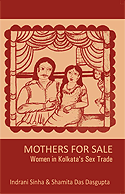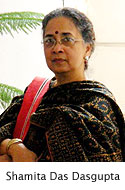 “My name is Shikha Morol. That’s not my real name, but I don’t want to tell you my real name. This is my name here. And please don’t take any pictures. I won’t allow it . . .”
“My name is Shikha Morol. That’s not my real name, but I don’t want to tell you my real name. This is my name here. And please don’t take any pictures. I won’t allow it . . .”
The woman in front of me sat with her head bowed. She wore a blue synthetic sari with garish floral prints and a mismatched purple blouse. She looked neat and clean but signs of poverty were evident in her work-roughened hands and broken nails.
Her name, she said, was Shikha, “a little flame.” She said she was 30. I was surprised. I assumed she was closer to 50.
This is how one of the interviews with Sikha, a sex worker in Sonagachhi Kolkata, starts in Shamita Dasgupta and Indrani Sinha’s latest book, “Mothers for Sale: Women in Kolkata’s Sex Trade”.
Kolkata sex workers have earned an international reputation through Oscar winning films like “Born into Brothels” (directed by Zana Briski) and their activism. Several novels have been written, several films made on these women and their lives, mostly my male writers and film makers. They portray them from different view points, sometimes as exploited women, sometimes as victims of poverty and social injustice, sometimes a lovers and sometimes just as sex objects. However, Shamita and Indrani looks at these women from a different perspective, as working mothers who sell their services to take care of their children and family.
“They tell me I am their son,” says Sikha about the greatest compliment that was bestowed upon her by her in-laws. Sikha’s husband, a landless laborer, killed himself few years ago leaving his parents and three children to be taken care of by Sikha, the sole bread earner. Shikha sold the milk of their cows, worked in a rice mill and picked vegetables in other people’s farms, sometimes working sixteen hours a day. But she couldn’t earn enough to properly feed her sons and her husband’s parents and through a series of accidents had to finally chose the oldest profession of sex trade. “I came of my free will”, she declared to Shamita and Indrani. She was not forced into this trade by anyone. Since she began her work in Shonagachhi, she had been regularly sending money orders to her parents-in-law for them and her three sons. But she hates this work and looks forward to the day when her children no longer need her money and she can “leave all this behind.”
As per the promotional material, the book Mothers for Sale attempts to offer an understanding of sex workers as mothers that goes beyond the current debate on the viability and legitimacy of sex work for women. It highlights the aspirations and fears, joys and disappointments, triumphs and failures that sex workers share with all mothers. The book is based on information gathered from more than 750 sex workers and more than 300 of their children through detailed interviews that the authors conducted since 2006. This is not fiction or fantasy that many writers and film makers have resorted to, to portray the conditions of the sex traders. This is an objective and compassionate study of a class of working women who are trying to make a living for themselves and their children.
The authors Shamita Dasgupta and Indrani Sinha have been working for women’s cause throughout their career. 
Shamita Dasgupta cofounded Manavi in New Jersey and is an adjunct faculty of law with the NYU Law School. Indrani Sinha founded Sanlaap in 1987 and works with women and young people fighting for their rights and protesting violence against women.
I sincerely congratulate them for their excellent work.

The book is published by A DASGUPTA-ALLIANCE PUBLICATION
Order your copy in the U.S. from: GLOBAL BOOKS: http://www.globalbooksus.com
For price discount on five (5) or more copies, please write to: globalbooksusa@gmail.com.
Good work !
GREAT TRUTH REVEALED